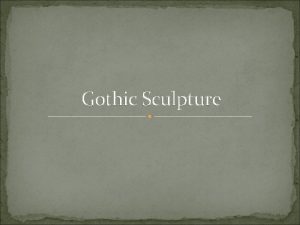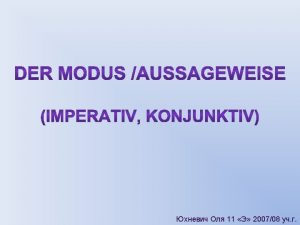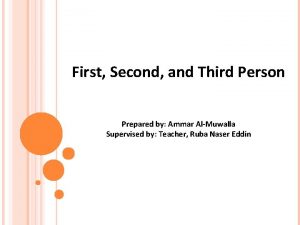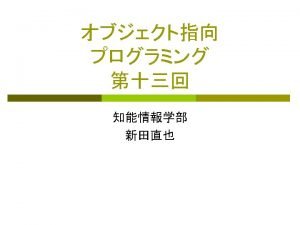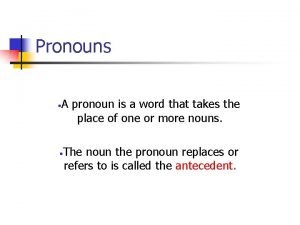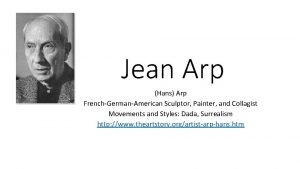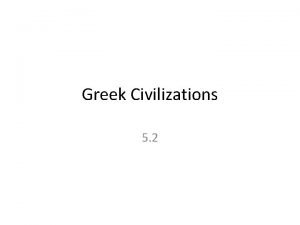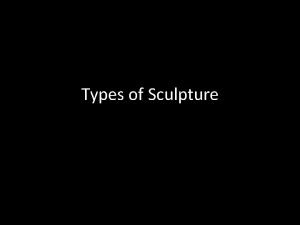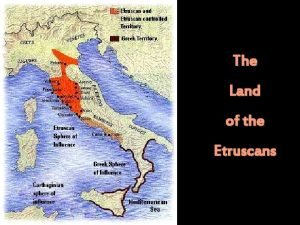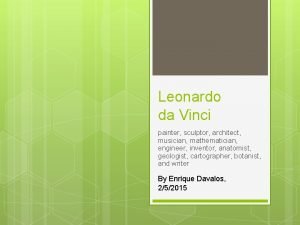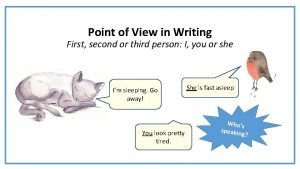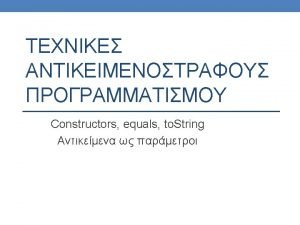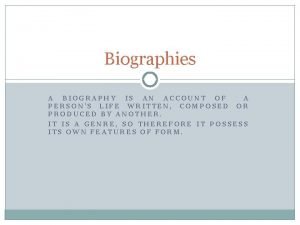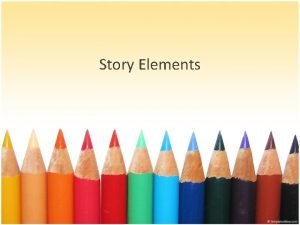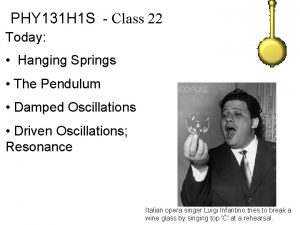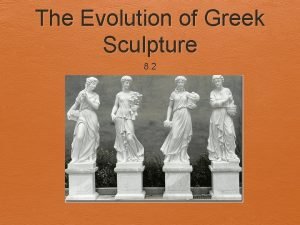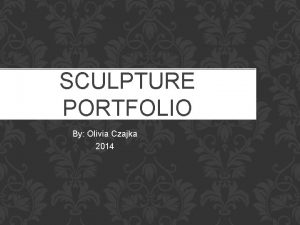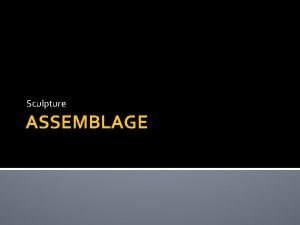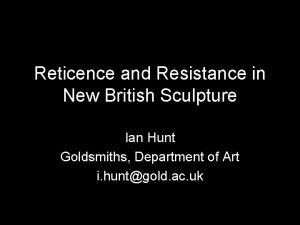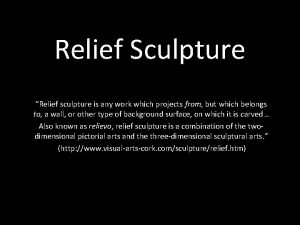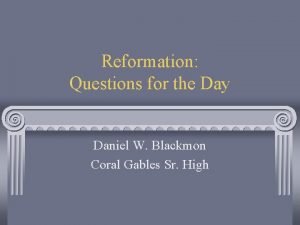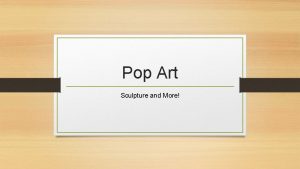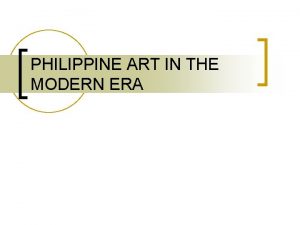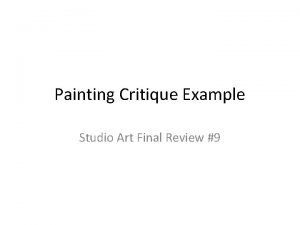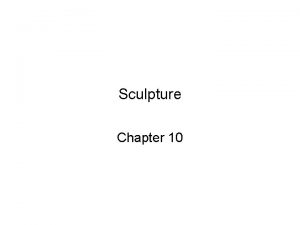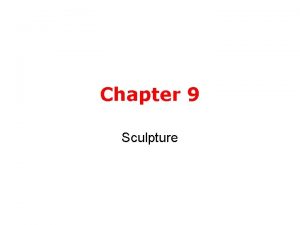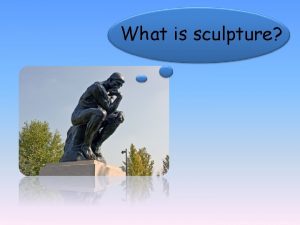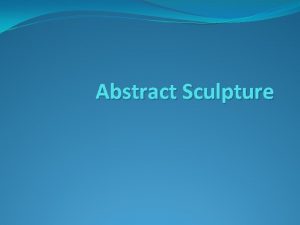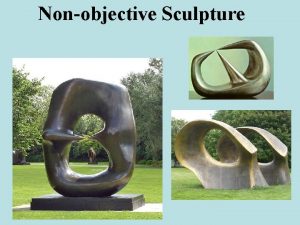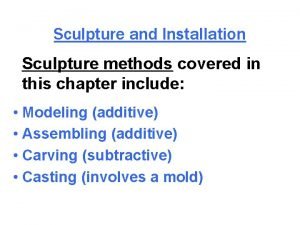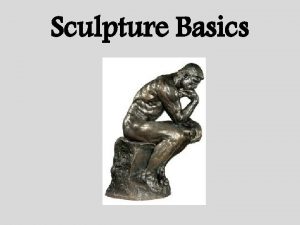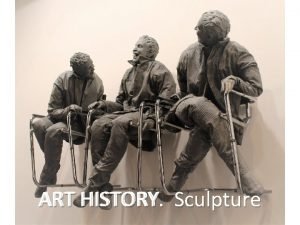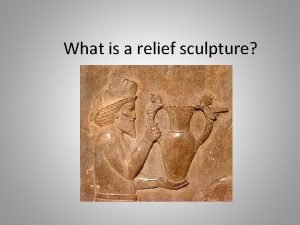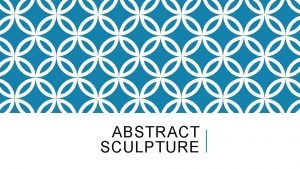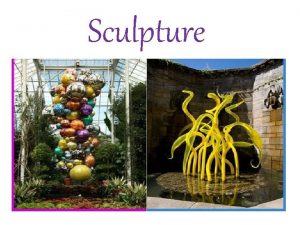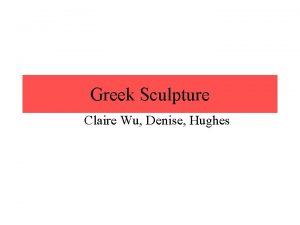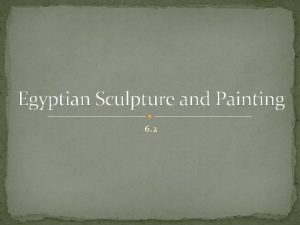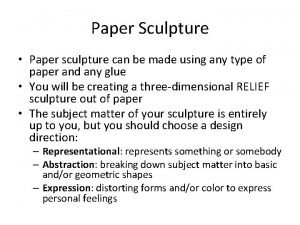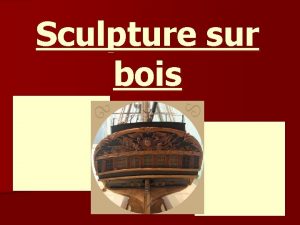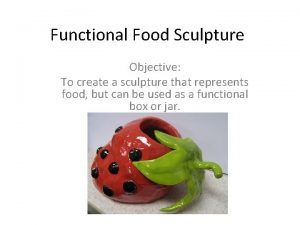Chapter 9 Sculpture A sculptor is a person


































- Slides: 34

Chapter 9 Sculpture

A sculptor is a person obsessed with the form and shape of things, and it’s not just the shape of one thing, but the shape of anything and everything: the hard, tense strength, although delicate form of a bone; the strong, solid fleshiness of a beech tree trunk. –Henry Moore

Introduction • What is sculpture? • Why is sculpture important to us? • Why does sculpture create an emotion in humans? • Why have we felt the need to create sculptures and monumental sculptures throughout our history?

Sculpture - The art of carving, casting, modeling, or assembling materials into three-dimensional figures or forms Relief sculpture • Bas-Relief or low relief • High Relief • Freestanding sculpture

Subtractive and Additive Types of Sculpture Subtractive Process - Carving, unwanted materials are removed. Additive Process - Modeling, Casting, Construction


Carving • Carving - removing portions of a block of material to create a form. • Can use stone, wood, ivory, chocolate…

Figure 9. 2, p. 179 MICHELANGELO. The Cross-Legged Captive (c. 1530– 1534). Marble. H: 7’ 6 1⁄2”.

Modeling - using a pliable material, such as clay or wax, the artist shapes the material into a 3 D form. • Can be done by hand or tools.

Casting - liquid metal material is poured into a mold to create a form. Mold - the form into which the material is poured and imparts its shape. • Any material that hardens can be used for casting. • One of the oldest and most common is Bronze.

Figure 9. 3, p. 179: LOUISE BOURGEOIS. Portrait of Robert (1969). Cast bronze with white patina. 13” x 12 1⁄2” x 10”.

The Lost-Wax Technique 1. The artist creates a form, and from this form a mold is created by covering the shape, usually in plaster or resin. 2. The inside of the mold is then filled or covered with wax. 3. The wax is removed and covered in a sandy mixture of silica, clay and plaster to create a investiture. • Investiture - a fire resistant mold into which the liquid metal will be poured. 4. The wax is heated and poured out of the now sold investiture and replaced with the liquid metal. 5. The finished metal sculpture is removed from the investiture, and burnished. • Burnished - treated chemically to take on a texture and color.

Figure 9. 6, p. 181: SHERRIE LEVINE. Fountains after Duchamp (1991). Bronze. Installation view at Sherrie Levine Exhibition in the Zürich Kunsthalle (2. 11. 1991– 3. 1. 1992), Zürich, Switzerland.

Figure 9. 7, p. 181: GEORGE SEGAL. Three Figures and Four Benches (1979). Painted bronze. 52” x 144” x 58”.

Construction Constructed sculpture - forms are built from materials such as wood, paper, string, sheet metal, and wire.

Types of Materials • • Stone Wood Clay Metal

Stone • • Stone is extremely hard It is also very durable Appropriate for monuments and statues Stone tools include the chisel, mallet, and rasp. • Artists also use contemporary power tools

Figure 9. 8, p. 182: LOUISE BOURGEOIS. Eyes (1982). Marble. 74 3⁄4” x 54” x 45 3⁄4”.

Wood • Wood can be carved, scraped, drilled, polished, molded and bent. • Different types of woods vary in how hard they are. • Wood appeals to sculpture artists, because of its grain, color, and workability. • Wood is easier to carve than stone. • Tensile strength - the inherent strength of a material.

Figure 9. 10, p. 184: PO SHUN LEONG. Figure (1993). Mahogany with hidden drawers. H: 50”.

Clay • Clay is more pliable than stone or wood – Clay is not very strong. – Nor is is permanent. • Armature - an inner skeleton normally made of metal, used to help give clay additional strength.

Metal • Metals can be cast, extruded, forged, stamped, drilled, filed, and burnished. • Cast bronze sculptures • Direct-metal sculptures - Assembling sculpture by welding, riveting, and soldering. • Patinas - the colors created on bronze due to oxidation.

Figure 9. 12, p. 185: RICHARD SERRA. Installation view, Guggenheim Museum, Bilbao, Spain.

Modern and Contemporary Materials and Methods Throughout history sculptors have searched for new forms of expression. • Constructed sculpture • Assemblage • Readymades • Mixed media • Kinetic sculpture • Light sculpture • Land art

Constructed sculpture • The artist “builds” the sculpture • Materials could include, sheet metal, cardboard, celluloid, or wire • Some artworks are lighter than those from stone or wood • Unorthodox materials can also be used

Constructed sculpture Figure 9. 13, p. 186 PABLO PICASSO. Mandolin and Clarinet (1913). Wood construction and paint.

Figure 9. 14, p. 186: CLAES OLDENBURG. Soft Toilet (1966). Vinyl filled with kapok painted with Liquitex, and wood. 57 1⁄16” x 27 5⁄8” x 28 1⁄16”.

Assemblage • A form of constructed sculpture • Pre-existing or found objects take on a new form as artwork • Novel combinations that take on a new life and meaning • One of the best-known examples is Picasso’s Bull’s Head

Readymades • Found objects can be elevated to works of art on pedestals, such as Duchamp’s urinal, turned upside down. • This is a 20 th-century artistic trend • No assembly is needed for this artform

Mixed Media - Use materials and found objects that are not normally elements of a work of art. • Artists, such as Rauschenberg (see Ch. 20), may attach other materials to their canvases. • What might be some the materials you could use in a Mixed Media sculpture?

Kinetic Sculpture Kinetic sculpture - Sculptures that move, art + action. Example: the mobile. Forms of movement might include: • Wind • Magnetic fields • Jets of water • Electric motors • The intensity of light • Human manipulations

Light Sculpture • Light and its reflections have always been an important elements in sculpture (and art!) • However, “light sculpture” is a 20 thcentury artform • What are the physical and psychological effects of color and the creation of illusion?

Other Materials Sculpture today uses not only traditional materials, but also materials that have never been used before. Example: beeswax, microcrystalline wax, chocolate, styrofoam, etc…

Figure 9. 22, p. 191: JANINE ANTONI. Chocolate Gnaw (1992). Chocolate (600 lb before biting), gnawed by the artist. 24” x 24” (61 cm x 61 cm).
 Romanesque and gothic sculpture
Romanesque and gothic sculpture Singular 2
Singular 2 Third person narrative
Third person narrative Person person = new person()
Person person = new person() Reflexive pronouns
Reflexive pronouns French-german sculptor jean
French-german sculptor jean Athenian sculptor whose true love was philosophy
Athenian sculptor whose true love was philosophy Sculptor charter school
Sculptor charter school What are the 3 types of sculpture
What are the 3 types of sculpture She wolf
She wolf As painter sculptor musician
As painter sculptor musician Is we third person writing
Is we third person writing First person vs third person writing
First person vs third person writing Person-job fit and person-organization fit
Person-job fit and person-organization fit External conflict fahrenheit 451
External conflict fahrenheit 451 Private.com
Private.com Chapter 18 safely moving the person
Chapter 18 safely moving the person Biography features
Biography features One person's garbage is another person's treasure
One person's garbage is another person's treasure When transferring a person
When transferring a person Man vs self examples
Man vs self examples Person a and person b
Person a and person b A person swings on a swing when the person sits still
A person swings on a swing when the person sits still Hi hi how are you doing
Hi hi how are you doing Dorphoros
Dorphoros Creating a dinosaur sculpture type of graphic organizer
Creating a dinosaur sculpture type of graphic organizer Olivia czajka
Olivia czajka Additive process sculpture
Additive process sculpture New british sculpture
New british sculpture Types of sculpture relief
Types of sculpture relief Types of relief sculpture
Types of relief sculpture The sculpture by bernini shown above celebrates
The sculpture by bernini shown above celebrates Modern pop art sculpture
Modern pop art sculpture Philippine art sculpture
Philippine art sculpture Art review example
Art review example
